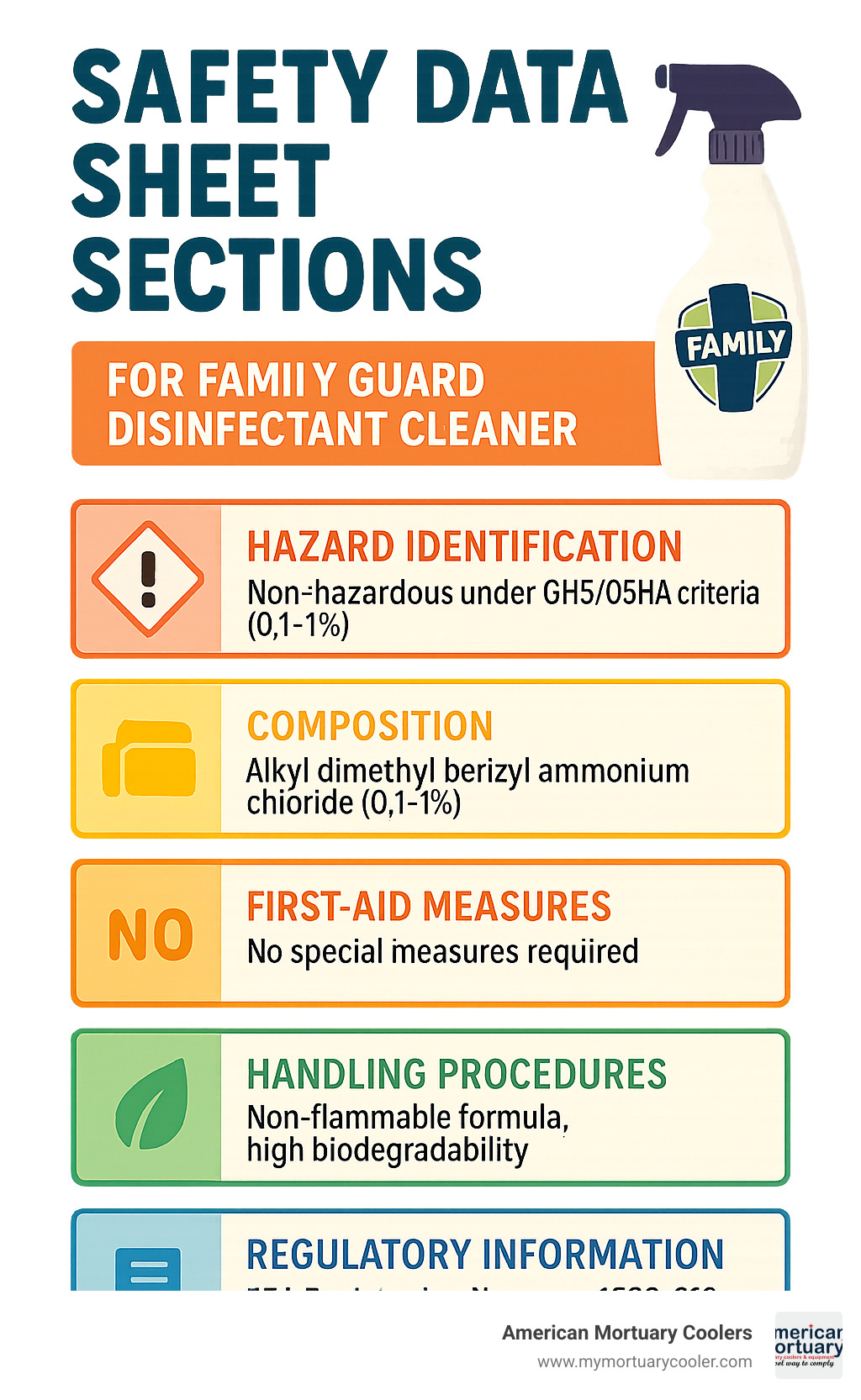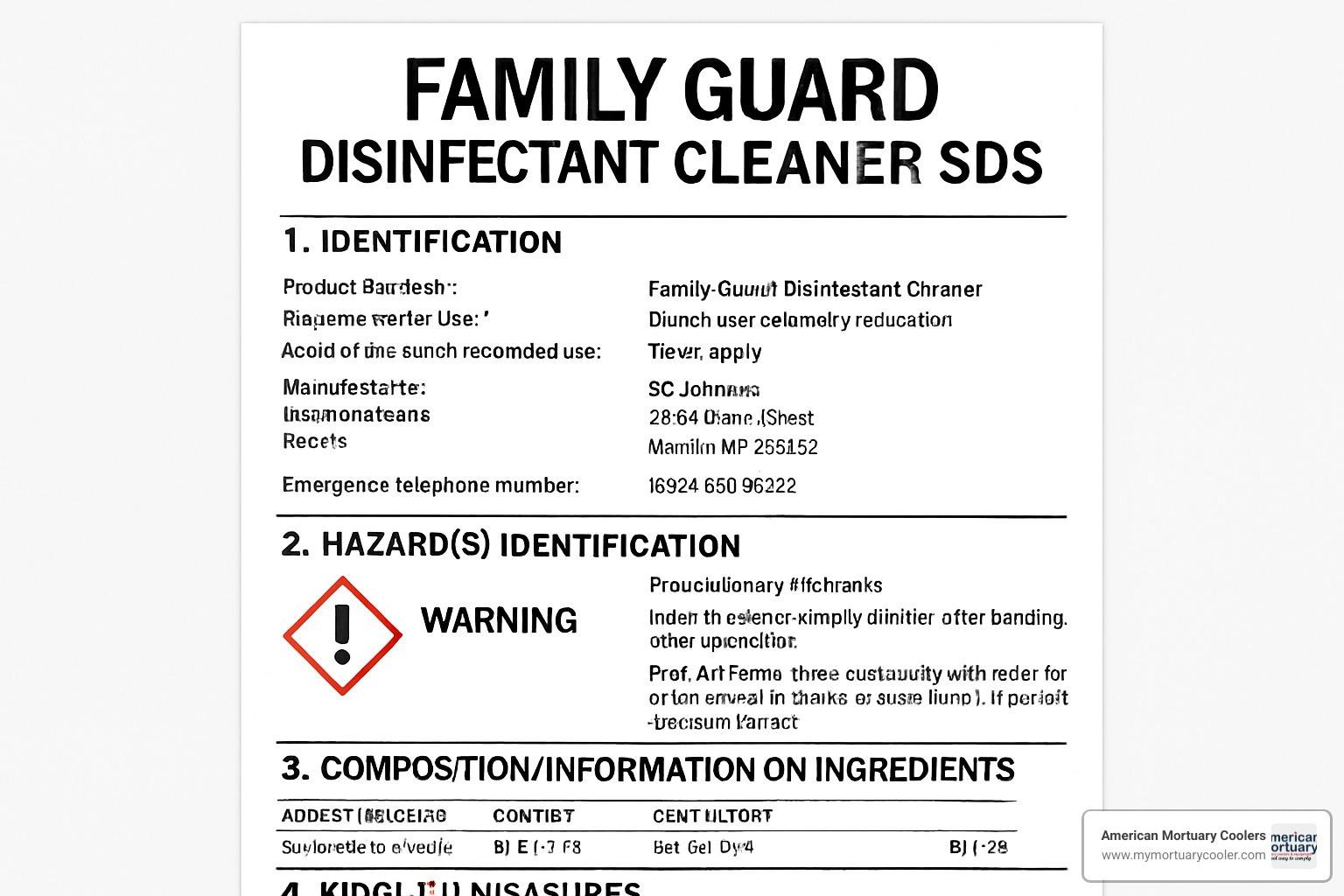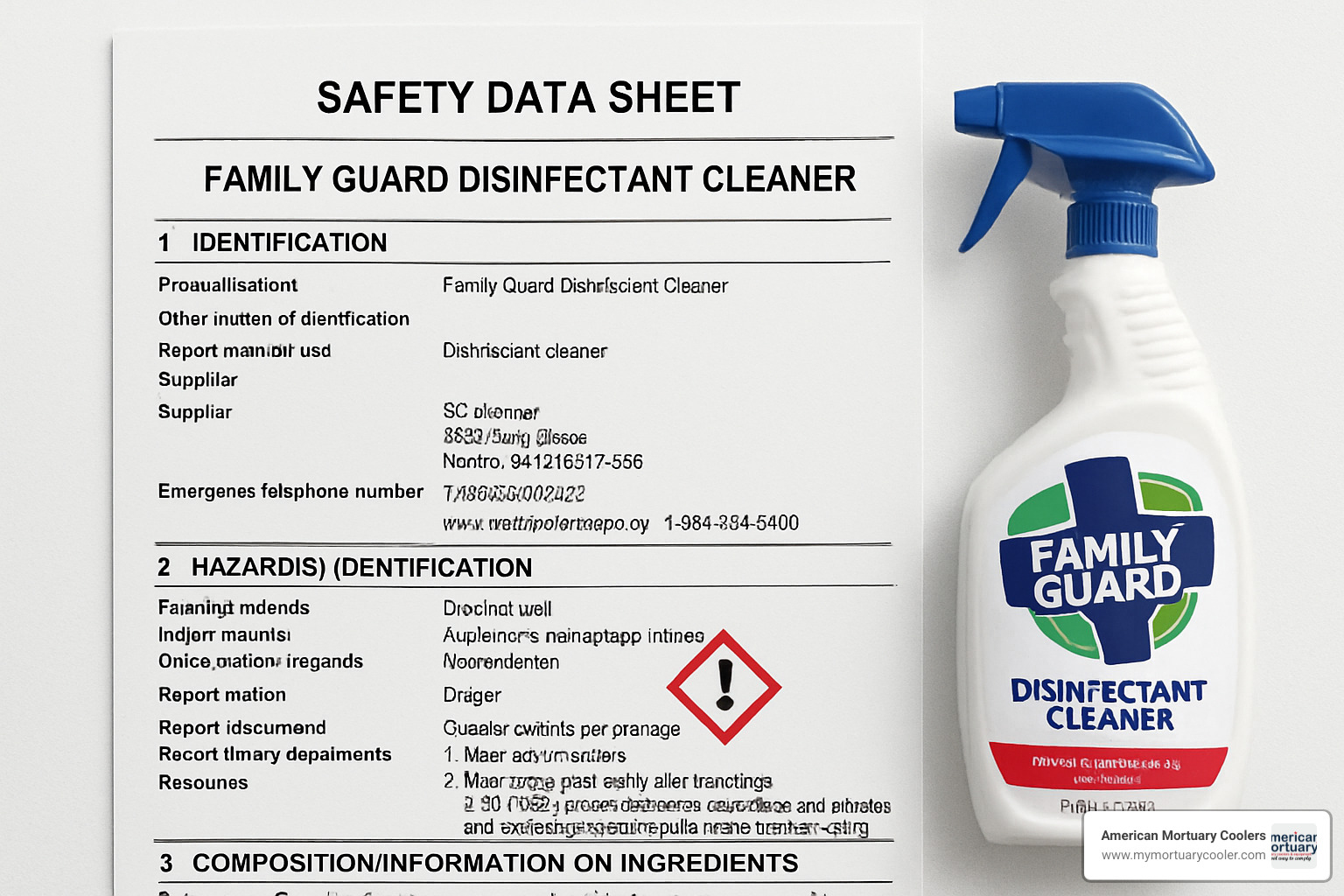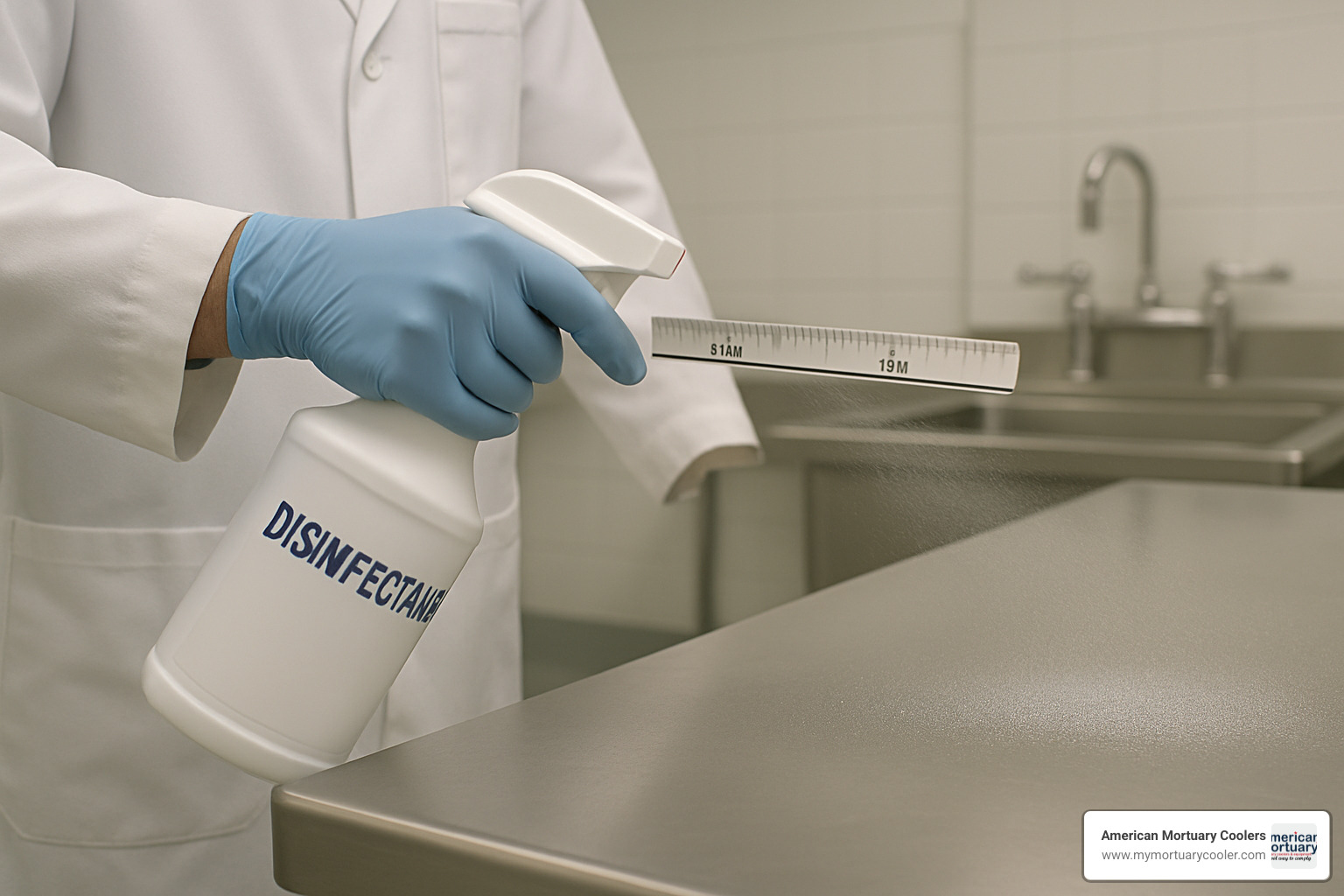
Everything You Need to Know About Family Guard Disinfectant Cleaner SDS
Understanding Safety Data Sheets for Disinfection Practices
If you're looking for information about family guard disinfectant cleaner sds, here's what you need to know:
| FamilyGuard™ Disinfectant Cleaner SDS Quick Facts |
|---|
| Active Ingredient: Alkyl dimethyl benzyl ammonium chloride (0.1-1%) |
| pH Level: 10.8 (non-corrosive) |
| Classification: Non-hazardous under GHS/OSHA criteria |
| VOC Content: 0.1% |
| Biodegradability: 95.5% in 28 days |
| EPA Registration: 4822-613 |
| Contact Time: 5 minutes for disinfection |
| SDS Access: Available through SC Johnson’s website |
The family guard disinfectant cleaner sds (Safety Data Sheet) provides essential information for safe handling, storage, and emergency procedures for this widely used disinfectant product. While primarily designed for home use, FamilyGuard™ Brand Disinfectant Cleaner is frequently used in professional settings including funeral homes and mortuary facilities due to its effective disinfection properties and relatively mild formulation.
Safety Data Sheets are critical documents required by OSHA for workplace use of chemical products. They contain standardized sections that outline hazards, composition, first-aid measures, and proper handling procedures. Unlike the product label, which focuses on directions for use, the SDS delivers comprehensive safety information needed for regulatory compliance and emergency response.
FamilyGuard™ Brand Disinfectant Cleaner stands out among quaternary ammonium–based disinfectants for its non-flammable formula and high biodegradability rating. The product is effective against a wide range of pathogens including Staphylococcus aureus, Salmonella enterica, Listeria monocytogenes, E. coli, and SARS-CoV-2 when used as directed with a 5-minute contact time.

Plain-Language Takeaway
Reading an SDS can feel overwhelming, so here’s a quick plain-English summary:
- The cleaner relies on a small amount of benzalkonium chloride (a “quat”) to rupture microbial cell walls.
- It is water-based, non-flammable, and produces almost no VOCs—good news for indoor air quality.
- With a pH of 10.8, it is mildly alkaline but gentle enough for stainless-steel mortuary coolers when used as directed.
- A 5-minute wet contact time is your ticket to killing 99.9 % of listed bacteria and viruses.
Armed with this knowledge, you’ll be better prepared to keep your facility compliant and your team safe.
Decoding the Family Guard Disinfectant Cleaner SDS

Ever tried to read a Safety Data Sheet and felt like you needed a chemistry degree? You're not alone! Let's break down the family guard disinfectant cleaner sds into plain English so you can understand exactly what you're working with in your facility.
When you first look at the SDS for FamilyGuard™ Disinfectant Cleaner, you'll notice it contains valuable information about what's in the bottle and how to use it safely. The product has a pH of 10.8, which means it's mildly alkaline but not corrosive enough to damage your equipment or surfaces. Good news for those stainless steel morgue coolers!
What I find particularly impressive is the environmental profile. With just 0.1% VOC content, it's practically free of those volatile organic compounds that can cause air quality issues. Even better, the active ingredients break down quickly in the environment – showing 95.5% biodegradation within 28 days.
The EPA registration number (4822-613) isn't just a random string of digits – it's your assurance that this product has been thoroughly tested and approved for its disinfection claims under FIFRA regulations.
family guard disinfectant cleaner sds: Active & Inert Ingredients
So what's actually in the bottle? The family guard disinfectant cleaner sds reveals a fairly simple formulation:
The star of the show is Alkyl dimethyl benzyl ammonium chloride (0.1-1%), a quaternary ammonium compound that does the heavy lifting against pathogens. It works by disrupting microbial cell membranes – think of it as popping the balloon that is a bacteria cell.
Supporting ingredients include diisopropanolamine (1-5%) which stabilizes the formula and adjusts the pH, while water makes up the majority (60-100%) as the carrier. There's also a touch of fragrance to leave things smelling fresh rather than clinical.
One important distinction to be aware of – the trigger spray version we're discussing is vastly different from the aerosol version. If you're ordering supplies for your funeral home, pay attention to which one you're getting:
| Comparison | FamilyGuard™ Trigger Cleaner | FamilyGuard™ Aerosol Spray |
|---|---|---|
| Active Ingredient | Alkyl dimethyl benzyl ammonium chloride (0.1-1%) | Ethyl alcohol (30-60%) + Alkyldimethylbenzylammonium saccharinate (0.1-1%) |
| Flammability | Non-flammable | Extremely flammable aerosol |
| VOC Content | 0.1% | 58.4% |
| Propellants | None | Isobutane (10-30%) + Propane (5-10%) |
| pH | 10.8 | Not specified |
| Primary Use | Hard surface disinfection | Surface disinfection + fabric deodorizing |
GHS & OSHA Hazard Summary for family guard disinfectant cleaner sds
When it comes to safety classifications, FamilyGuard™ Trigger Cleaner is about as gentle as disinfectants come. It's classified as Eye Irritation Category 2B under GHS standards – basically meaning it might cause some temporary eye irritation if it splashes in your eyes, but nothing that won't resolve quickly with proper rinsing.
Both the HMIS and NFPA ratings are 0-0-0 across the board for health, flammability, and reactivity hazards. In chemical safety, that's basically the equivalent of getting straight A's!
First-Aid & Medical Response
Even with gentle products, it's important to know what to do if something goes wrong. The family guard disinfectant cleaner sds gives clear guidance:
For eye contact, rinse with water for at least 15 minutes while holding your eyelids open. Take out contact lenses if you're wearing them, and keep rinsing. If your eyes still feel irritated afterward, check with a doctor.
If it gets on your skin, simply wash with soap and water. Only if irritation develops and sticks around should you need medical advice.
For inhalation issues, moving to fresh air should resolve any mild respiratory irritation. If breathing problems continue, that's when medical attention becomes necessary.
In the unlikely event of ingestion, rinse the mouth and sip some water to dilute the product. Don't try to make yourself throw up – that often causes more harm than good. If you're concerned, call Poison Control or a doctor.
Safe Handling, Storage & Disposal Best Practices

Here at American Mortuary Coolers, we've seen how proper chemical handling makes all the difference in funeral home settings. While the family guard disinfectant cleaner sds shows it's one of the gentler disinfectants out there, a little care goes a long way in keeping everyone safe.
Handling Recommendations
Even though FamilyGuard™ is classified as non-hazardous, we still recommend some common-sense precautions. Wearing gloves and safety glasses isn't strictly required, but we've found they're worth using, especially if you have sensitive skin or are tackling a big cleaning job in a preparation room.
Good ventilation matters too. When you're disinfecting inside a mortuary cooler or small preparation area, proper airflow helps everyone breathe easier. And here's something critically important – never mix this product with bleach or other cleaners. The SDS specifically warns against mixing with strong oxidizing agents, as this could create hazardous gases.
For best results, store your FamilyGuard™ between 40-90°F (4-32°C). We've noticed that extreme temperatures can affect both the stability and effectiveness of disinfectants.
Spill & Accident Procedures
If you spill a small amount of FamilyGuard™, simply wipe it up with absorbent materials like paper towels. For larger spills, you'll want to contain and dike the liquid using materials like sand, vermiculite, or commercial absorbents that you hopefully have on hand.
After collecting the absorbed material in appropriate containers, give the area a good rinse with water. One thing we appreciate about this product is that it's safe for wastewater treatment systems thanks to its impressive 95.5% biodegradability rate within 28 days.
Recent research on quaternary ammonium compounds (the active ingredients in this cleaner) has shown that while they're highly effective against pathogens, some can persist in the environment. Fortunately, the specific quat used in FamilyGuard™ breaks down much more readily than many alternatives. You can learn more about quats persistence on the FamilyGuard website.
Disposal & Environmental Stewardship
When it's time to dispose of FamilyGuard™, the SDS provides straightforward guidance:
For unused or waste product, follow your local regulations – in most cases, you can safely pour diluted product down the drain with plenty of water. For the containers, we recommend the triple-rinse method before recycling. The HDPE plastic bottles are recyclable in most community programs.
Transportation & Regulatory Snapshot
Here's some good news for your paperwork load – according to the family guard disinfectant cleaner sds, this product isn't regulated as hazardous material for transportation under DOT regulations. That simplifies shipping and receiving considerably.
Other key regulatory details include its EPA Registration number 4822-613 (confirming its approved disinfectant status), its listing under the TSCA inventory, and its exemption from California Prop 65 reporting requirements.
For more information about selecting appropriate protective equipment when working with this and other chemicals, check out our guide to choosing personal protective gear.
Directions for Cleaning, Disinfecting & Sanitizing Hard Surfaces

Let's talk about how to get the most out of your FamilyGuard™ Disinfectant Cleaner. The family guard disinfectant cleaner sds works hand-in-hand with the product label to ensure proper usage.
When it comes to basic cleaning, start by holding the spray bottle about 6-8 inches from the surface. This distance matters! Too close and you'll soak the surface unnecessarily; too far and you won't get proper coverage. For everyday messes, just spray and wipe with a clean cloth. Got something stubborn? Let the cleaner sit for a few minutes before wiping.
For proper disinfection (crucial in mortuary settings), there's a bit more to it. First, remove any visible soil or grime. Then spray until the surface is thoroughly wet and let it sit for a full 5 minutes. This dwell time is non-negotiable if you want to eliminate pathogens! After that, you can either wipe it down or let it air dry.
I've seen many funeral directors rush this process, but those 5 minutes are what make the difference between a surface that looks clean and one that's actually disinfected.
If you're just looking to sanitize (which requires less contact time than full disinfection), you'll still pre-clean, but you only need to keep the surface wet for 30 seconds to eliminate common bacteria like Staph and Klebsiella.
For any surface that might come into contact with food, always rinse with clean water after cleaning or disinfecting.
Surface Compatibility & Restrictions
One thing I love about FamilyGuard™ is how versatile it is. According to the family guard disinfectant cleaner sds, it's compatible with sealed granite, quartz countertops, acrylic, stainless steel, ceramic, porcelain, ABS plastic, metal surfaces, tile, and wood laminate.
This versatility is why we often recommend it to our mortuary clients. The stainless steel interiors of our coolers need effective disinfection without the risk of corrosion that comes with bleach products.
That said, there are a few surfaces you'll want to avoid. Unfinished wood can absorb the moisture and warp. Unsealed natural stone might etch or stain. And any surface already damaged by water probably won't respond well to a water-based cleaner.
Not sure about a particular surface? Test in a small, hidden spot first. And remember to unplug electrical equipment before cleaning it.
Sensitive Individuals: Asthma & Allergy Precautions
While the family guard disinfectant cleaner sds shows this product is gentler than many industrial disinfectants, we all know someone with sensitivities. If you or your staff members fall into this category, a few simple precautions go a long way.
First, good ventilation makes a huge difference, especially in smaller spaces like preparation rooms. Open a window if possible, or use exhaust fans. For those sensitive to fragrances, consider looking into fragrance-free alternatives.
For staff with sensitive skin, providing nitrile gloves is a thoughtful touch. Safety glasses can also protect those with sensitive eyes.
Need more guidance on protective gear for mortuary settings? Our guide to choosing personal protective gear covers everything you need to know.
Emergency Misuse Scenarios & Immediate Actions
Even with the safest products, accidents happen. The family guard disinfectant cleaner sds provides clear guidance for those "uh-oh" moments:
If someone accidentally swallows the product, don't induce vomiting. Instead, rinse their mouth and have them sip water to dilute. Call Poison Control at 1-800-222-1222 if symptoms develop.
For eye contact, flush with plenty of water for at least 15 minutes. Remove contact lenses first if possible. For skin irritation, soap and water usually does the trick. If someone inhales too much spray mist, move them to fresh air.
It's worth noting that the trigger spray version we're discussing is much safer than the aerosol version of FamilyGuard™. The aerosol contains flammable propellants and alcohol, creating fire hazards that the trigger spray doesn't have.
Environmental & Regulatory Insights for Infection-Control Professionals
When selecting disinfectants for mortuary settings, you need to balance effectiveness with environmental responsibility. The family guard disinfectant cleaner sds offers valuable information on both fronts.
FamilyGuard™ Brand Disinfectant Cleaner eliminates 99.9% of germs and viruses on hard, non-porous surfaces when used according to directions. This includes proven effectiveness against SARS-CoV-2 with a 5-minute contact time – an important consideration for facilities managing infectious disease risks.
From an environmental standpoint, this product shows several positive attributes:
- The active ingredient achieves 95.5% biodegradation within just 28 days
- It contains minimal VOCs (only 0.1%)
- The non-flammable formulation improves safety and storage flexibility
It's worth noting that the SDS indicates the active ingredient has an LC50 for fathead minnow of 0.28 mg/L over 96 hours. This means that while the product breaks down well over time, you should avoid direct discharge of concentrated product into waterways.

Efficacy Data & Contact Times
The family guard disinfectant cleaner sds and related product documentation confirm effectiveness against numerous pathogens relevant to mortuary environments. Staphylococcus aureus can be eliminated with either a 5-minute disinfection contact time or a quicker 30-second sanitization process. Other common concerns like Salmonella enterica, Listeria monocytogenes, and E. coli are all addressed with the standard 5-minute contact time, achieving 99.9% elimination rates.
Viral pathogens don't stand much chance either – SARS-CoV-2, Influenza A, and Respiratory Syncytial Virus (RSV) are all effectively neutralized with the 5-minute dwell time. For facilities concerned about environmental contamination, the product also provides fungistatic protection against Aspergillus niger (mold/mildew).
This comprehensive protection makes FamilyGuard™ Disinfectant Cleaner particularly well-suited for general disinfection throughout mortuary facilities. From preparation rooms to cooler interiors, you'll have confidence in controlling the wide range of potential pathogens that might be present.
While the 5-minute contact time is slightly longer than some hospital-grade alternatives, this tradeoff brings benefits in the form of a gentler formulation and reduced health risks for your staff.
Workplace Compliance & Documentation
If your funeral home or mortuary facility uses FamilyGuard™ Disinfectant Cleaner, OSHA requires several documentation practices to maintain compliance:
First, the family guard disinfectant cleaner sds must be readily available to all employees who might use or be exposed to the product. This accessibility can be provided through either paper copies or electronic formats, but the key requirement is immediate access without barriers.
You'll also need to maintain training records documenting that your staff has received proper instruction on hazard communication, including how to interpret and apply SDS information. Keeping an updated inventory of all hazardous chemicals used in your workplace is another requirement, along with ensuring all containers carry proper labeling.
These requirements fall under OSHA's Hazard Communication Standard (29 CFR 1910.1200), designed to ensure your employees have the information they need to work safely with chemical products.
For more helpful tips on maintaining clean and compliant mortuary facilities, check out our Keep It Clean blog, where we share practical advice based on our years of experience serving the funeral industry.
Frequently Asked Questions about FamilyGuard™ Disinfectant Cleaner SDS

Does the cleaner require PPE even though it's non-hazardous?
You might wonder if you really need protective gear when using a product classified as non-hazardous. While the family guard disinfectant cleaner sds does indeed classify this product as non-hazardous under official GHS/OSHA criteria, we still recommend some basic protection as a smart precaution.
Think of it like wearing an apron while cooking – not always necessary, but it prevents those little splashes from ruining your day. For those with sensitive skin, wearing gloves during prolonged or repeated contact makes good sense. Similarly, eye protection becomes your friend whenever there's a chance of splashing, though it's not strictly required by regulations.
As for masks or respirators? You can breathe easy – they're not needed during normal use as long as you have decent ventilation in your workspace.
Can I use it on mortuary cooler interiors without corrosion risk?
"Will this stuff eat through my expensive cooler?" It's a question we hear often, and I'm happy to reassure you that FamilyGuard™ Disinfectant Cleaner plays nicely with stainless steel mortuary cooler interiors. The family guard disinfectant cleaner sds confirms a pH of 10.8, which is mildly alkaline but won't corrode your stainless steel equipment.
In fact, at American Mortuary Coolers, we actually prefer quaternary ammonium-based disinfectants like FamilyGuard™ over bleach products for our coolers. Why? They don't release those nasty chlorine vapors that can damage refrigeration components over time. Plus, they keep working after application, providing ongoing antimicrobial protection.
For best results when cleaning your cooler, make sure the surface stays visibly wet for the full 5-minute contact time. Then, give it a quick wipe-down to prevent water spots on that beautiful stainless steel finish.
What's the shelf life after opening the bottle?
According to the manufacturer, your opened bottle of FamilyGuard™ Disinfectant Cleaner should maintain its germ-fighting powers for about a year, provided you store it properly. The family guard disinfectant cleaner sds recommends keeping it in a cool, dry place, away from direct sunlight.
For those unopened bottles sitting in your supply closet, you've got about two years from the manufacture date (conveniently printed on the bottle) before you need to worry about effectiveness.
Want to squeeze every last day of usefulness out of your disinfectant? Keep the cap tightly closed when not in use, store between 40-90°F, and avoid freezing. Also, keep it away from heat sources that might alter its chemical composition.
How can you tell if it's time to say goodbye to your trusty bottle? Watch for changes in color, scent, or consistency. If the product no longer foams properly when sprayed, it's likely past its prime and should be replaced.
Conclusion
When it comes to maintaining a safe, clean environment in funeral homes and mortuary settings, understanding the family guard disinfectant cleaner sds isn't just about compliance—it's about confidence. This Safety Data Sheet serves as your roadmap to using this product effectively and safely, providing all the critical details that complement what you'll find on the product label.
What makes FamilyGuard™ Disinfectant Cleaner stand out is its thoughtful balance of power and gentleness. The quaternary ammonium formulation packs a punch against pathogens while being remarkably gentle on surfaces and users. That 5-minute contact time might seem like a small detail, but it's your guarantee that everything from common bacteria to SARS-CoV-2 is being effectively neutralized.
Here at American Mortuary Coolers, we're more than just equipment suppliers—we're your partners in maintaining the highest standards of care. Our custom-built coolers aren't just functional; they're designed with cleaning and disinfection in mind. The smooth stainless steel interiors, properly sealed seams, and thoughtful drainage systems all work together to make your disinfection routine more effective and less time-consuming.
We understand that in the funeral profession, cleanliness isn't just about appearance—it's about respect, dignity, and safety. That's why we're committed to helping you find the right balance of equipment and protocols that protect everyone who enters your facility, from staff members to the families you serve during their most vulnerable moments.
If you're looking to upgrade your morgue refrigeration solutions with systems designed for optimal sanitation and ease of maintenance, we invite you to explore our complete range of morgue refrigeration solutions.
With the right equipment, effective disinfectants, and proper protocols, your facility can maintain impeccable standards even during the most challenging circumstances. That's not just good business—it's good care.



